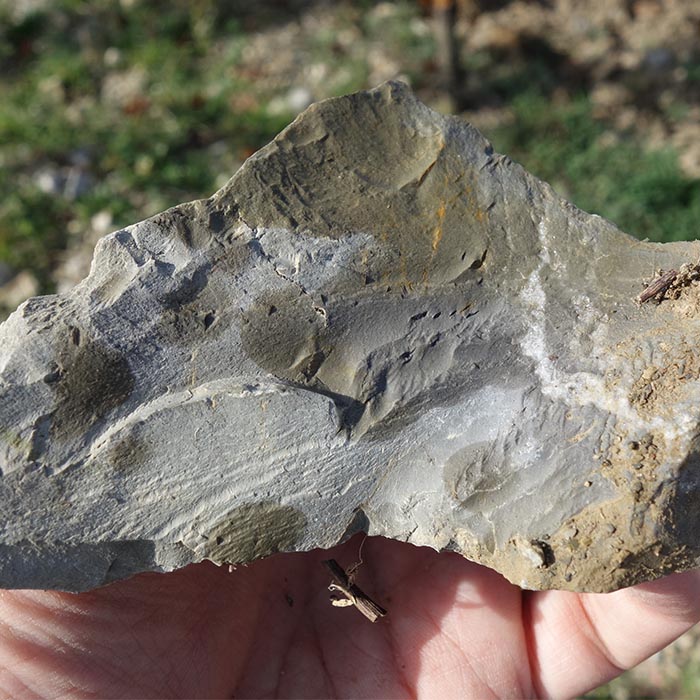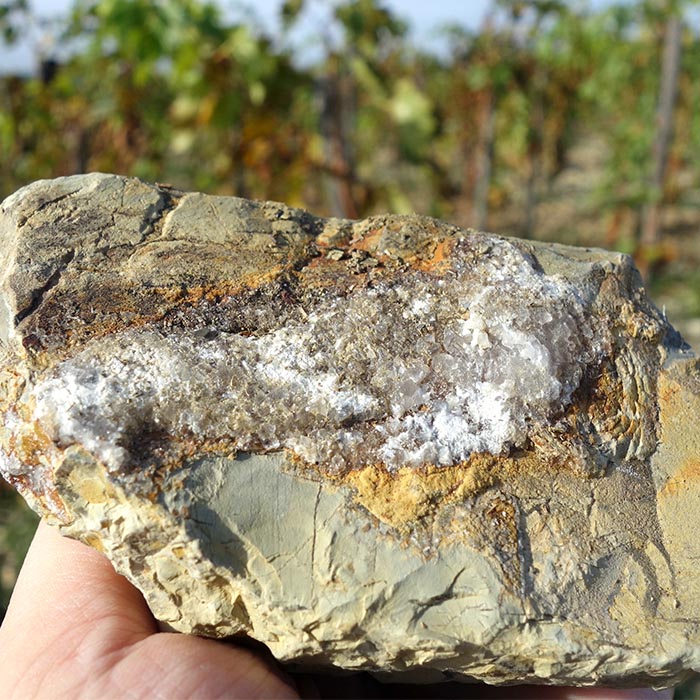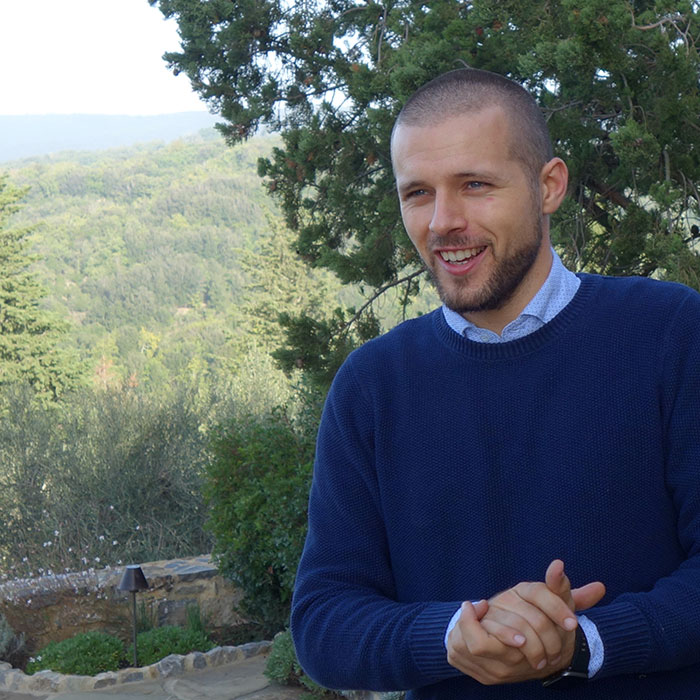Marchese Lamberto Frescobaldi tells us over dinner that he had a sense of achievement that day: "We had an enquiry for our sparkling wine from Canada. I had to decline because we don't have any more in stock. I confess that it's good to be able to say once in a while, "Sorry, we're sold out!"
It is no wonder that demand for the Leonia Pomino Brut from Frescobaldi's Castello di Pomino is high: the spumante, fermented according to the traditional method on the estate, is a lively and elegant wine that clearly benefits from the altitude of its growing zone. So: let's go to Pomino.
Frescobaldi calls Castello di Pomino "The hidden jewel of Tuscany". It lies 35 km east of Florence in the first foothills of the Apennines. The 108 hectares of vineyards range in altitude from 400 to 750 metres and are surrounded by forests. The history of the Castello goes back to the year 1500. In 1716, Prince Cosimo III de Medici named Pomino one of Tuscany's four preferred wine-growing regions. In 1855, Leonia degli Albizi, the wife of Angiolo Frescobaldi, introduced the grape varieties Chardonnay, Pinot Noir and Pinot Blanc, which had been unknown in the region until then. In 1983, the small area of Pomino, most of which is owned by the Castello, was given its own protected designation of origin: Pomino DOC, it is also the only DOC for Spumante in Tuscany.
The Sangiovese and Merlot that were also grown here in the past have been replaced by Chardonnay and Pinot Noir, not least because of the great demand for the sparkling wines. These were produced for the first time in 2011. Today, Frescobaldi produces around 50,000 bottles of Leonia Pomino Brut Pomino DOC Brut Millesimato from 80 percent Chardonnay and 20 percent Pinot Blanc and 8,000 bottles of Leonia Pomino Rosé Brut Millesimato from Pinot Noir every year. In addition to Italy's first barrel-aged white wine - the Chardonnay Benefizio Pomino Bianco Riserva DOC - the grapes for single-varietal still Pinot Noir, the Cuvée Pomino Bianco and the sweet Vinsanto also grow here. At the time of the visit, the grapes were hung up to dry ("appassimento"), a very elaborate method that hardly anyone uses anymore. At the end of February, it ferments in small wooden barrels ("caratelli"), where it matures for six to seven years.
Oenologist Francesca Pratesi explains: "In 2022, we started the harvest in mid-August with the Chardonnay, followed by the Pinot Noir at the end of August. Since we need a lot of grapes for the Spumante, we start quite early despite the altitude." This altitude is also key to the winery's future. As Pratesi tells it, Pomino is less susceptible to drought because of it. She now also grows a lot of ground cover between the rows of vines to keep the sandy-loamy soils moist. From 2023, all vineyards will be cultivated without herbicides. She is also working with her team to extend the vineyards to an altitude of 800 metres. "In any case, we want to keep Pomino special because it is unique in Tuscany!"
Not far from Pomino, but much lower in the Chianti Rufina wine-growing zone, lies Castello Nipozzano , which has existed since the 11th century. The name means "without well". To the east one sees the Apennines, towards the southeast the valleys of the rivers Arno and Sieve. "Here, these climatic influences mix and that gives our wines a special phenolic ripeness and aroma," explains oenologist Lorenzo Portaro. "The Rufina landscape is more open, not so small-structured, and much more homogeneous than that of Chianti Classico. Our wines therefore have more acidity and are very storable," says the young winemaker. As if to prove this, the Frescobaldi family's personal wine collections lie in a cellar of the Castello. The 240 hectares on limestone and clay soils are 80 percent planted with Sangiovese, the vineyards are located between 300 and 500 metres above sea level.
The best-known wines from Castello Nipozzano come from single vineyards: the Montesodi Chianti Rufina Riserva DOCG is a single-varietal Sangiovese. Montesodi means "hard mountain", and the vineyard, situated at an altitude of 400 metres, had to be planted with the help of dynamite. 1974 was its first vintage. The Mormoreto Toscana IGT is made from Cabernet Sauvignon, Cabernet Franc and Petit Verdot. At present, late-ripening Cabernet and Petit Verdot are also increasingly planted, but Portaro continues to believe in Sangiovese: "We are experimenting with new rootstocks and looking for new clone selections for more resistant vines." He is also experimenting himself. For example, he allows whole berries to co-ferment in eight barriques and hopes that this will bring more freshness to the wines. "The next time you come back, we can taste it," he promises.
Castelgiocondo was one of the first Brunello producers at the beginning of the 19th century. From 1972, Vittorio Frescobaldi worked here as technical director, and in 1989 the family bought the estate. The 110 hectares of vineyards lie at altitudes between 200 and 450 metres and are surrounded by forests. In the lower-lying vineyards, the soils consist of blue clay - this is where the estate's Merlot is grown, which makes up around five percent of the vineyard stock, and from which the single-varietal Lamaione comes. Higher up, where only Sangiovese is grown, the clay is mixed with sandstone and in the highest plots the vines are on Galestro slate.
 Blue clay dominates the lower sites of Castelgiocondo.
Blue clay dominates the lower sites of Castelgiocondo. Clay and sandstone are mixed in the middle areas.
Clay and sandstone are mixed in the middle areas. Davide Bozzon is oenologist at Castelgiocondo
Davide Bozzon is oenologist at CastelgiocondoOenologist Davide Bozzon explains that these two terroirs are a great advantage for Castelgiocondo because they give the chance to experiment in a wide variety of conditions. He is convinced of the future of Sangiovese in Tuscany: "It is best adapted to the climate, and it will continue to adapt." In the case of Merlot, which is suffering particularly from climate change, Castelgiocondo is also focusing on adaptability and new findings. "Maybe one day Merlot will have to be replaced by Cabernet Sauvignon and Cabernet Franc. But for the time being, we continue to rely on it and to plant it," says Bozzon. For the future, ponds will be built and irrigation systems installed. Bozzon: "We don't irrigate to increase yields, but just enough so that the plant doesn't die of thirst. It's important that the vineyard manager and cellar master work very well together, and that works extremely well for us." In an experimental vineyard on the premises, experiments are being carried out with different clones and rootstock vines. The material obtained there is already being used for new plantings.
Overall, it seems as if Frescobaldi is facing the challenges of climate change with a certain composure, without ignoring them. "There have already been many changes over the centuries, and they have not been mastered by actionism, but by observing nature, reflecting, reacting prudently and helping to shape the innovations," says Marchese Lamberto Fresobaldi. "Where necessary, we intervene and adapt, but we always try to keep our history and traditions in mind. Our family has been growing wine in Tuscany for 900 years. This experience teaches us to accept change without panicking. And," he alludes to the welcome, "we shouldn't have done so badly if our wines are so popular!"
Note: The trip was at the invitation of Frescobaldi.
All photos © Alexander Lupersböck